Jackalope fans, take note: Your mythical beast really does exist!
http://ww2.lafayette.edu/~hollidac/jackalope.html
E-mail to Chuck Holliday hollidac@lafayette.edu or Dan Japuntich dajapuntich@yahoo.com
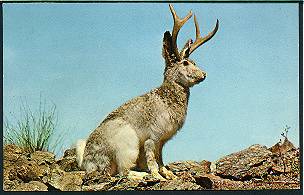 The jackalope, a cottontail or domestic rabbit or jackrabbit mounted
with the horns of a young antelope, deer or goat (here are several pictures of jackalopes) is commonly believed to have originated in the folklore of the American West. A recent obituary in The New York Times
attributes the origin of the American Jackalope to Douglas Herrick, a
native of Douglas, Wyoming, in 1939. However, Dan Simberloff (1987, see
the "Jackalope References" link at the bottom of this page) notes that
local legend has it that the original jackalope was displayed in 1829
by the owner of a Douglas hotel, LeRoy Ball, although this seems about
50 years early for a hotel to be built in Douglas, which was
incorporated in 1887. Kreider and Bartlett (1981) also note: "Horned
jackrabbits and cottontail rabbits were known to the pioneers of the
western plains and were first described in popular hunting and fishing
magazines in the early 1900's." Ernest Thompson Seton published in 1909
his Life-Histories of Northern Game Animals, in which he included a drawing of the head of what was certainly a mounted jackalope,
shown to him by a Chicago gentleman. Seton also reported seeing
diseased cottontail rabbits in the American West that had growths
resembling horns.
The jackalope, a cottontail or domestic rabbit or jackrabbit mounted
with the horns of a young antelope, deer or goat (here are several pictures of jackalopes) is commonly believed to have originated in the folklore of the American West. A recent obituary in The New York Times
attributes the origin of the American Jackalope to Douglas Herrick, a
native of Douglas, Wyoming, in 1939. However, Dan Simberloff (1987, see
the "Jackalope References" link at the bottom of this page) notes that
local legend has it that the original jackalope was displayed in 1829
by the owner of a Douglas hotel, LeRoy Ball, although this seems about
50 years early for a hotel to be built in Douglas, which was
incorporated in 1887. Kreider and Bartlett (1981) also note: "Horned
jackrabbits and cottontail rabbits were known to the pioneers of the
western plains and were first described in popular hunting and fishing
magazines in the early 1900's." Ernest Thompson Seton published in 1909
his Life-Histories of Northern Game Animals, in which he included a drawing of the head of what was certainly a mounted jackalope,
shown to him by a Chicago gentleman. Seton also reported seeing
diseased cottontail rabbits in the American West that had growths
resembling horns.
Jackalope postcards have been available since the 1930's and several towns have offered jackalope hunting licenses as novelties. Douglas, Wyoming,
even has an annual festival, Jackalope Days, on the second Friday and
Saturday of June each year. The Governor of the State of Wyoming in
1985 proclaimed
Douglas to be the "Home of the Jackalope." Mounted heads of this
legendary animal are offered for sale at truck stops, roadside
restaurants (and now on the www) all over the country and Wall Drug has a six-foot fiberglass jackalope on display. Even a U.S. President has owned a mounted jackalope. There are also several www sites devoted to jackalopes and they are occasionally covered in popular articles. Like snipe hunts, jackalope hunts have been used as a ritual form of hazing in rural communities.
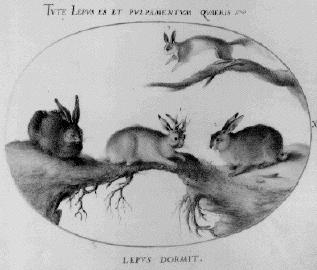 However, a far older reference to a horned hare (Lepus cornutus
in Latin) is shown in the picture on the right. It was painted by Joris
Hoefnagel in the late 1570's. Albrecht Durer aficionados will note
Hoefnagel's copy of Durer's famous hare at the left of this picture
(see it in it's full glory at The National Gallery of Art www site.) The Keio University Digital Research Library has a digitized copy of the 1606 edition of Conrad Gesner's Thierbuch (a German version of his Historia Animalium Liber I: De Quadrupedibus Viviparis by Konrad Forer, first published in 1563) and it also contains a figure of Lepus cornutus. Manda Jost of Harvard University tells me (7/99) that there is another old European publication, Physica Curiosa,by P. Gaspar Schott (1667), which details horned hares on its frontispiece and in the text. Schott's illustrator copied the two horned hares by Matthaeus Merian in Johannes Jonstonus's Theatrum
Universale Omnium Animalium (1650). Thanx, Manda, and thanx to Dan Japuntich for scanning these pictures and doing the www research to find them!
However, a far older reference to a horned hare (Lepus cornutus
in Latin) is shown in the picture on the right. It was painted by Joris
Hoefnagel in the late 1570's. Albrecht Durer aficionados will note
Hoefnagel's copy of Durer's famous hare at the left of this picture
(see it in it's full glory at The National Gallery of Art www site.) The Keio University Digital Research Library has a digitized copy of the 1606 edition of Conrad Gesner's Thierbuch (a German version of his Historia Animalium Liber I: De Quadrupedibus Viviparis by Konrad Forer, first published in 1563) and it also contains a figure of Lepus cornutus. Manda Jost of Harvard University tells me (7/99) that there is another old European publication, Physica Curiosa,by P. Gaspar Schott (1667), which details horned hares on its frontispiece and in the text. Schott's illustrator copied the two horned hares by Matthaeus Merian in Johannes Jonstonus's Theatrum
Universale Omnium Animalium (1650). Thanx, Manda, and thanx to Dan Japuntich for scanning these pictures and doing the www research to find them!
Even the famous Encyclopedie Methodique volume of plates published in 1789 has a figure of a horned hare by Robert Benard (on left); 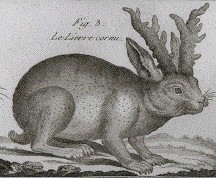 this figure is a copy of an engraving which first apeared in Jacob Klein's Summa Dubiorum Circa Classes
Quadrupedum et Amphibiorum
in 1743. Many thanks to Erwin Pokorny for giving us the correct
chronology and sources for most of the works cited above (10/03). Thus, many of the naturalists of the 16th through 18th centuries believed that horned rabbits really existed. Interestingly, the writer Francois Rabelais seems not to have believed in horned hares: In the prologue to Gargantua
(1534), Rabelais notes that "Silenes of old were little painted boxes,
like those we now may see in the shops of apothecaries, painted on the
outside with wanton toyish figures, as harpies, satyrs, bridled geese,
horned hares, saddled ducks, flying goats, thiller harts, and other
suchlike counterfeted pictures at discretion, to excite people unto
laughter ..."
this figure is a copy of an engraving which first apeared in Jacob Klein's Summa Dubiorum Circa Classes
Quadrupedum et Amphibiorum
in 1743. Many thanks to Erwin Pokorny for giving us the correct
chronology and sources for most of the works cited above (10/03). Thus, many of the naturalists of the 16th through 18th centuries believed that horned rabbits really existed. Interestingly, the writer Francois Rabelais seems not to have believed in horned hares: In the prologue to Gargantua
(1534), Rabelais notes that "Silenes of old were little painted boxes,
like those we now may see in the shops of apothecaries, painted on the
outside with wanton toyish figures, as harpies, satyrs, bridled geese,
horned hares, saddled ducks, flying goats, thiller harts, and other
suchlike counterfeted pictures at discretion, to excite people unto
laughter ..."
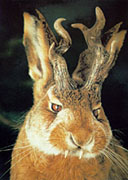
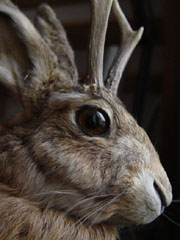 Perhaps
immigrants to the U.S. from Europe brought the idea of the horned hare
with them and this has evolved into our modern jackalope. This notion
is strengthened by the fact that illustrations of horned hares were
included in the Encyclopedie Methodique (1782-1832) and in some 18th century German schoolbooks
and would, thus, have been known to many people through their
schooling. More modern huntsmen's tales about European horned hares
also exist: the Austrian raurackl, the Bavarian wolpertinger (a composite animal with horns and parts from hares and other animals, see Wiedemann, 2000, for it's origin), the Thuringian rasselbock
shown on the left, and the dilldapp in Switzerland; all from the 19th
or 20th centuries). Again, our thanks to Erwin Pokorny for the links
above, the names and homes of the many mythical European horned hares,
the picture of his own raurackl (right) and the reference to al Qazwini
below. Dr. Pokorny has just published a scholarly article on horned
hares in the catalog of an art exhibition about courtly hunting in
Tyrol: Herrlich Wild - Hoefische Jagd in Tirol, Ambras
Castle, Innsbruck 2004, pp. 64-80. This article is a treasure trove of
material on horned hares and has a wealth of interesting figures; a
formal reference is included here.
It also introduces the interesting possibility that, because the first
European reference to a horned hare was made in 1517, Europeans
returning from the New World may have brought the Shope papillomavirus
with them and, thus, infected their native hares (more on the Shope
papillomavirus below).
Perhaps
immigrants to the U.S. from Europe brought the idea of the horned hare
with them and this has evolved into our modern jackalope. This notion
is strengthened by the fact that illustrations of horned hares were
included in the Encyclopedie Methodique (1782-1832) and in some 18th century German schoolbooks
and would, thus, have been known to many people through their
schooling. More modern huntsmen's tales about European horned hares
also exist: the Austrian raurackl, the Bavarian wolpertinger (a composite animal with horns and parts from hares and other animals, see Wiedemann, 2000, for it's origin), the Thuringian rasselbock
shown on the left, and the dilldapp in Switzerland; all from the 19th
or 20th centuries). Again, our thanks to Erwin Pokorny for the links
above, the names and homes of the many mythical European horned hares,
the picture of his own raurackl (right) and the reference to al Qazwini
below. Dr. Pokorny has just published a scholarly article on horned
hares in the catalog of an art exhibition about courtly hunting in
Tyrol: Herrlich Wild - Hoefische Jagd in Tirol, Ambras
Castle, Innsbruck 2004, pp. 64-80. This article is a treasure trove of
material on horned hares and has a wealth of interesting figures; a
formal reference is included here.
It also introduces the interesting possibility that, because the first
European reference to a horned hare was made in 1517, Europeans
returning from the New World may have brought the Shope papillomavirus
with them and, thus, infected their native hares (more on the Shope
papillomavirus below).
The Persian scholar, Zakariya Ibn
Muhammad al-Qazwini (1203-1283, also known as the "Moslem Pliny")
produced a geographic dictionary, Kitab 'aja'ib al-makhluqat wa-ghara'ib al-mawjudat,(Marvels of Things Created and Miraculous Aspects of Things Existing) 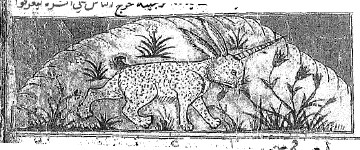 in
which he presented a legend about Alexander the Great's adventures on
an island in the China Sea, "Tinnin". Alexander is said to have helped
the islanders to kill a dragon by feeding it poisoned cattle. The
grateful islanders gave Alexander several gifts, including a large and
ferocious yellow animal with black spots and a dark horn (shown on
left). Although al Qazwini did not give the animal a name, other
medieval Muslim scholars copied his manuscript and called the animal
"al Miradj", a horned hare, and added an appropriate illustration.
However, Michel Wiedemann (2000) makes a good case for a translator's
error changing "monoceros" (Greek for rhinoceros) into al Qazwini's
"hare" in the later, copied manuscripts. Thus, what Alexander really
got from the legendary islanders may have been a rhinoceros or a
unicorn (note the spiral horn), either one a truly inconvenient gift to
give someone on a long sea voyage!
in
which he presented a legend about Alexander the Great's adventures on
an island in the China Sea, "Tinnin". Alexander is said to have helped
the islanders to kill a dragon by feeding it poisoned cattle. The
grateful islanders gave Alexander several gifts, including a large and
ferocious yellow animal with black spots and a dark horn (shown on
left). Although al Qazwini did not give the animal a name, other
medieval Muslim scholars copied his manuscript and called the animal
"al Miradj", a horned hare, and added an appropriate illustration.
However, Michel Wiedemann (2000) makes a good case for a translator's
error changing "monoceros" (Greek for rhinoceros) into al Qazwini's
"hare" in the later, copied manuscripts. Thus, what Alexander really
got from the legendary islanders may have been a rhinoceros or a
unicorn (note the spiral horn), either one a truly inconvenient gift to
give someone on a long sea voyage!
Dan Japuntich has found a truly ancient
reference to a horned rabbit (an absurd one in this case - a Dharma
Bunny?) in the Bhuddist Dharmas. For example, in the Shurangama Sutra,
Volume 1, Part Two, Sutra text:
Page 159: The Buddha said to
Ananda, "You say that the mind with its aware nature that perceives and
makes discriminations is not located anywhere at all. Everything
existing in the world consists of space, the waters, and the land,
the creatures that fly and walk, and all external objects. Would your
non-attachment also exist?
Page 160: "If it did not exist, it would be
the same as fur on a tortoise or horns on a rabbit. Just what would
that non-attachment be?"
It's tempting to opine that, if the Buddha and his
disciples had spent a little less time trying to negate themselves and
to focus inward, they might have actually seen a few horned rabbits
(see below) and used a different simile. There is a www page (http://www.rzc.org/html/library/zenbow/jackalopeself.shtml) which fully discusses these ideas and others from the Dharmas.
Finally, and of most interest to me, Dan
Japuntich has informed me (7/98) that there is a papillomavirus which
can cause horn-like growths on rabbits' heads, so there really are rabbits which, at a distance, appear to have horns.
Esther van Praag maintains an excelent www site on rabbit diseases
which automatically downloads a PDF showing rabbits infected with Shope
papilloma virus, but it is not for the squeamish.
Such animals are probably responsible for the jackalope, raurackl,
rasselbock, wolpertinger, dilldapp and similar legends in the U.S.,
Europe and in African folk tales and for the belief in the existence of
horned hares by naturalists in the 16th through 18th centuries. I have
also just discovered (10/03) Dan Simberloff's excellent article (Natural History,
August 1987, p. 50) and the paper by Kreider and Bartlett (1981) which
present the same notion. Details and references to the scientific and
popular literature are noted below by Dan Japuntich (distilled from
several e-mails we have exchanged and posted with his permission as
well as being updated 7/99 and 10/00). Thanks, Dan!
JACKALOPES: HORN-LIKE GROWTHS ON RABBITS AND HARES IS A REAL DISEASE
By Dan Japuntich (dajapuntich@yahoo.com)
Many years ago I was taking my 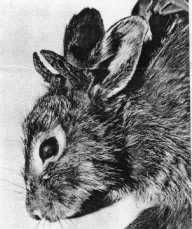 children
through the Science Museum of Minnesota in St, Paul. One of the biology
exhibits showed jars of cottontail rabbits with cranial tumors shaped
like horns, and these were presented with reference to the Jackalope
legend. About 6 years ago, during a cottontail population boom in St.
Paul, I was riding my bike along the Mississippi River and saw a number
of rabbits in a meadow. At least two of them had growths on their
heads. We are in rabbit population-boom years here in Minnesota
(1998-99), and when I recently mentioned to some of my co-workers that
these are good jackalope finding summers, they looked at me as if I was
pulling their legs. I had thought that this knowledge about real horned
rabbits as related to the Jackalope legend (the "raurackl", stag-hare
legend in Germany) was fairly common. When I decided to research the
subject, I found very little on the web. I did, however, come across
Chuck Holliday's web page, where he has kindly attached this evolving
article on horned bunnies and hares.
children
through the Science Museum of Minnesota in St, Paul. One of the biology
exhibits showed jars of cottontail rabbits with cranial tumors shaped
like horns, and these were presented with reference to the Jackalope
legend. About 6 years ago, during a cottontail population boom in St.
Paul, I was riding my bike along the Mississippi River and saw a number
of rabbits in a meadow. At least two of them had growths on their
heads. We are in rabbit population-boom years here in Minnesota
(1998-99), and when I recently mentioned to some of my co-workers that
these are good jackalope finding summers, they looked at me as if I was
pulling their legs. I had thought that this knowledge about real horned
rabbits as related to the Jackalope legend (the "raurackl", stag-hare
legend in Germany) was fairly common. When I decided to research the
subject, I found very little on the web. I did, however, come across
Chuck Holliday's web page, where he has kindly attached this evolving
article on horned bunnies and hares.
The center specimen in Hoefnagel's c.
late 1550's copy of Albrecht Durer's famous rabbit picture looks just
like the rabbits in the Science Museum of St. Paul and like the ones I
saw on my bike ride. They do not look exactly like the
taxidermist-modified rabbit jackalopes with deer antlers, but are close
enough to make one do a double take. A good example of a real
cottontail jackalope photograph from O.B. Lee (1965) is shown at the right. Gaspar Schott's (1667, p. 900) Lepores cornuti
plate shows horned hares and treats them as a separate species, but a
look at the horns shows them to be non-uniform and more like tumors.
(Thanks to Manda Clair Jost for spotting the Schott plate and giving me
a chance to play in the Rare Books Libraries, and, by the way, I am
getting a translation of Schott's Latin text).
NOTE: More pictures of real jackalopes (cottontail rabbits infected with the Shope papillomavirus) are available here.
In June 1998, I called the Science Museum
of MN resident biologist, Richard Oehlenschlager, who said that, while
the old specimens are not on display at this time, they are still in
the museum archives. He identified the tumors as being caused by a
papillomavirus. This prompted me to do a little more investigation
about papillomaviruses. I condensed my findings and added to the
information contained in the class notes for PAT 707, Pathology of
Laboratory Animals prepared by Trenton R. Schoeb, Department of
Comparative Medicine University of Alabama at Birmingham; this
information is no longer available on the www.
The growth of rabbit tumors in the shape
of horns or antlers is a common rabbit disease called papillomatosis,
caused by a papillomavirus. A papillomavirus is the same sort of
disease that causes the growth of warts on humans. The disease is very
common in cottontails.
The agent causing the growth of tumors in
the shape of horns on the head of rabbits is the Shope papillomavirus,
which was first reported in Shope (1933) (Genus Papillomavirus, family
Papovaviridae). It is a natural disease in cottontail rabbits (the
natural hosts, Sylvilagus floridanus) and is most common in Midwest and Great Plains states. Jackrabbits (Lepus sp.)
are also susceptible. Since horned rabbit legends occur in America,
Europe and Asia, it probably has a wide distribution. In the U.S.A.,
the distribution is shown in the included Kreider and Bartlett (1981) map,
and the reasons responsible for this localization are unknown. As a
natural disease in domestic rabbits it has been reported only from
Southern California. Natural transmission probably occurs mostly via
the rabbit tick Haemaphysalis leporis-palustris according
to C.L. Larson (1936). Mosquitoes and reduviid bugs can also transmit
and are a more likely source of infection in commercial rabbitries. In
Minnesota, the horns are predominantly found on the head and neck, a
location consistent with the passage of biting insects (Larson et al.,1936), while in Kansas they are predominant on the perineum on the rabbits' behind, but can occur on the head as well.
The study of Shope papillomavirus as a viral cause of cancer has been ongoing for over 50 years, since
one of its analogs in humans is genital warts. John Kreider, MD and
other researchers at Pennsylvania State University College of Medicine
have been using rabbits and this virus in research on cancer. The
objective of their research program is two-fold: to determine the
contribution of human papillomaviruses (HPV) to the development of
uterine cervical cancer and to develop effective means for the
prevention and treatment of infections. Kreider just recently retired,
but he and his researchers eventually did develop a vaccine for HPV's.
Other research into Shope papillomavirus is extensive, including DNA
analyses of its forms. William Phelps (1985) did extensive work on the
Shope virus by trapping wild cottontails in Minnesota and identifying
two major viral-specific RNA species.
as a viral cause of cancer has been ongoing for over 50 years, since
one of its analogs in humans is genital warts. John Kreider, MD and
other researchers at Pennsylvania State University College of Medicine
have been using rabbits and this virus in research on cancer. The
objective of their research program is two-fold: to determine the
contribution of human papillomaviruses (HPV) to the development of
uterine cervical cancer and to develop effective means for the
prevention and treatment of infections. Kreider just recently retired,
but he and his researchers eventually did develop a vaccine for HPV's.
Other research into Shope papillomavirus is extensive, including DNA
analyses of its forms. William Phelps (1985) did extensive work on the
Shope virus by trapping wild cottontails in Minnesota and identifying
two major viral-specific RNA species.
In his comprehensive review of the
subject, Kreider (1981) included one of the original plates showing the
"jackalope" specimens the great naturalist Ernest Thompson Seton (1937)
had drawn during his early excursions (picture on right). According to
the newspaper accounts referenced below, in 1990 the Museum of Natural
History at the University of Kansas had an exhibit and a traveling
road-show dealing with real jackalopes. This should come as no
surprise, since John Kreider had numerous correspondence with E.R.
Hall, one of the museum's mammalogists. According to Tom Swearingen, a
director at the Museum, they have many interesting mounted specimens,
and perhaps they will lend some images and history to this article. I
have also talked again recently (7/99) with Richard Oehlenschlager at
the Science Museum of MN, and he says he has a donated jackalope in his
freezer. I will see if I can get some pictures.
We are in another rabbit population boom
this year (1998) in St, Paul, and I'm going to be on the look-out for
more jackalopes down near the Mississippi. This time I'm bringing my
camera.
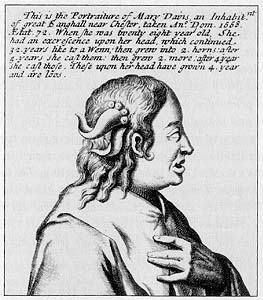 A
note from Dan added 10/16/00 reads: I want you to know that we had two
jackalope sightings in St. Paul this summer, but I have yet to get more
than a distant picture of one. We have an overabundance of bunnies this
year. Interestingly, the bunnies along the Mississippi River near my
house have all but disappeared.
A
note from Dan added 10/16/00 reads: I want you to know that we had two
jackalope sightings in St. Paul this summer, but I have yet to get more
than a distant picture of one. We have an overabundance of bunnies this
year. Interestingly, the bunnies along the Mississippi River near my
house have all but disappeared.
More pictures of real jackalopes (cottontail rabbits infected with the Shope papillomavirus) are available here.
A final note from Chuck: As it turns out,
horns may be found in unusual places on a wide variety of
normally-horned and hornless mammals, including humans (picture at
left). They arise, as in rabbits, at the sites of benign, precancerous
or cancerous skin growths, usually on sun-exposed skin, and are
composed of keratin, the structural material in fingernails. The first
report of such a human horn occurs in the European literature in 1599,
and a much better-documented horn was received by the Ashmolean Museum,
Oxford, in 1685. This horn was one of several grown and shed by Mary
Davis, then 69 years old. The original figure of Ms. Davis and her horn
may be seen here
and is also shown in an article by A. McGregor (1983). Several medical
www sites present detailed information on human cutaneous horns; three
are here, here, and here.
Updated 8/16/04
Jackalope references.
Return
 visits since 4/11/03. Counter by WEBcounter
visits since 4/11/03. Counter by WEBcounter
 The jackalope, a cottontail or domestic rabbit or jackrabbit mounted
with the horns of a young antelope, deer or goat (here are several pictures of jackalopes) is commonly believed to have originated in the folklore of the American West. A recent obituary in The New York Times
attributes the origin of the American Jackalope to Douglas Herrick, a
native of Douglas, Wyoming, in 1939. However, Dan Simberloff (1987, see
the "Jackalope References" link at the bottom of this page) notes that
local legend has it that the original jackalope was displayed in 1829
by the owner of a Douglas hotel, LeRoy Ball, although this seems about
50 years early for a hotel to be built in Douglas, which was
incorporated in 1887. Kreider and Bartlett (1981) also note: "Horned
jackrabbits and cottontail rabbits were known to the pioneers of the
western plains and were first described in popular hunting and fishing
magazines in the early 1900's." Ernest Thompson Seton published in 1909
his Life-Histories of Northern Game Animals, in which he included a drawing of the head of what was certainly a mounted jackalope,
shown to him by a Chicago gentleman. Seton also reported seeing
diseased cottontail rabbits in the American West that had growths
resembling horns.
The jackalope, a cottontail or domestic rabbit or jackrabbit mounted
with the horns of a young antelope, deer or goat (here are several pictures of jackalopes) is commonly believed to have originated in the folklore of the American West. A recent obituary in The New York Times
attributes the origin of the American Jackalope to Douglas Herrick, a
native of Douglas, Wyoming, in 1939. However, Dan Simberloff (1987, see
the "Jackalope References" link at the bottom of this page) notes that
local legend has it that the original jackalope was displayed in 1829
by the owner of a Douglas hotel, LeRoy Ball, although this seems about
50 years early for a hotel to be built in Douglas, which was
incorporated in 1887. Kreider and Bartlett (1981) also note: "Horned
jackrabbits and cottontail rabbits were known to the pioneers of the
western plains and were first described in popular hunting and fishing
magazines in the early 1900's." Ernest Thompson Seton published in 1909
his Life-Histories of Northern Game Animals, in which he included a drawing of the head of what was certainly a mounted jackalope,
shown to him by a Chicago gentleman. Seton also reported seeing
diseased cottontail rabbits in the American West that had growths
resembling horns.
 However, a far older reference to a horned hare (Lepus cornutus
in Latin) is shown in the picture on the right. It was painted by Joris
Hoefnagel in the late 1570's. Albrecht Durer aficionados will note
Hoefnagel's copy of Durer's famous hare at the left of this picture
(see it in it's full glory at
However, a far older reference to a horned hare (Lepus cornutus
in Latin) is shown in the picture on the right. It was painted by Joris
Hoefnagel in the late 1570's. Albrecht Durer aficionados will note
Hoefnagel's copy of Durer's famous hare at the left of this picture
(see it in it's full glory at  this figure is a copy of an engraving which first apeared in Jacob Klein's Summa Dubiorum Circa Classes
Quadrupedum et Amphibiorum
in 1743. Many thanks to Erwin Pokorny for giving us the correct
chronology and sources for most of the works cited above (10/03). Thus, many of the naturalists of the 16th through 18th centuries believed that horned rabbits really existed. Interestingly, the writer Francois Rabelais seems not to have believed in horned hares: In the prologue to Gargantua
(1534), Rabelais notes that "Silenes of old were little painted boxes,
like those we now may see in the shops of apothecaries, painted on the
outside with wanton toyish figures, as harpies, satyrs, bridled geese,
horned hares, saddled ducks, flying goats, thiller harts, and other
suchlike counterfeted pictures at discretion, to excite people unto
laughter ..."
this figure is a copy of an engraving which first apeared in Jacob Klein's Summa Dubiorum Circa Classes
Quadrupedum et Amphibiorum
in 1743. Many thanks to Erwin Pokorny for giving us the correct
chronology and sources for most of the works cited above (10/03). Thus, many of the naturalists of the 16th through 18th centuries believed that horned rabbits really existed. Interestingly, the writer Francois Rabelais seems not to have believed in horned hares: In the prologue to Gargantua
(1534), Rabelais notes that "Silenes of old were little painted boxes,
like those we now may see in the shops of apothecaries, painted on the
outside with wanton toyish figures, as harpies, satyrs, bridled geese,
horned hares, saddled ducks, flying goats, thiller harts, and other
suchlike counterfeted pictures at discretion, to excite people unto
laughter ..."
 Perhaps
immigrants to the U.S. from Europe brought the idea of the horned hare
with them and this has evolved into our modern jackalope. This notion
is strengthened by the fact that illustrations of horned hares were
included in the Encyclopedie Methodique (1782-1832) and in some 18th century German
Perhaps
immigrants to the U.S. from Europe brought the idea of the horned hare
with them and this has evolved into our modern jackalope. This notion
is strengthened by the fact that illustrations of horned hares were
included in the Encyclopedie Methodique (1782-1832) and in some 18th century German  in
which he presented a legend about Alexander the Great's adventures on
an island in the China Sea, "Tinnin". Alexander is said to have helped
the islanders to kill a dragon by feeding it poisoned cattle. The
grateful islanders gave Alexander several gifts, including a large and
ferocious yellow animal with black spots and a dark horn (shown on
left). Although al Qazwini did not give the animal a name, other
medieval Muslim scholars copied his manuscript and called the animal
"al Miradj", a horned hare, and added an appropriate illustration.
However, Michel Wiedemann (2000) makes a good case for a translator's
error changing "monoceros" (Greek for rhinoceros) into al Qazwini's
"hare" in the later, copied manuscripts. Thus, what Alexander really
got from the legendary islanders may have been a rhinoceros or a
unicorn (note the spiral horn), either one a truly inconvenient gift to
give someone on a long sea voyage!
in
which he presented a legend about Alexander the Great's adventures on
an island in the China Sea, "Tinnin". Alexander is said to have helped
the islanders to kill a dragon by feeding it poisoned cattle. The
grateful islanders gave Alexander several gifts, including a large and
ferocious yellow animal with black spots and a dark horn (shown on
left). Although al Qazwini did not give the animal a name, other
medieval Muslim scholars copied his manuscript and called the animal
"al Miradj", a horned hare, and added an appropriate illustration.
However, Michel Wiedemann (2000) makes a good case for a translator's
error changing "monoceros" (Greek for rhinoceros) into al Qazwini's
"hare" in the later, copied manuscripts. Thus, what Alexander really
got from the legendary islanders may have been a rhinoceros or a
unicorn (note the spiral horn), either one a truly inconvenient gift to
give someone on a long sea voyage!
 children
through the Science Museum of Minnesota in St, Paul. One of the biology
exhibits showed jars of cottontail rabbits with cranial tumors shaped
like horns, and these were presented with reference to the Jackalope
legend. About 6 years ago, during a cottontail population boom in St.
Paul, I was riding my bike along the Mississippi River and saw a number
of rabbits in a meadow. At least two of them had growths on their
heads. We are in rabbit population-boom years here in Minnesota
(1998-99), and when I recently mentioned to some of my co-workers that
these are good jackalope finding summers, they looked at me as if I was
pulling their legs. I had thought that this knowledge about real horned
rabbits as related to the Jackalope legend (the "raurackl", stag-hare
legend in Germany) was fairly common. When I decided to research the
subject, I found very little on the web. I did, however, come across
Chuck Holliday's web page, where he has kindly attached this evolving
article on horned bunnies and hares.
children
through the Science Museum of Minnesota in St, Paul. One of the biology
exhibits showed jars of cottontail rabbits with cranial tumors shaped
like horns, and these were presented with reference to the Jackalope
legend. About 6 years ago, during a cottontail population boom in St.
Paul, I was riding my bike along the Mississippi River and saw a number
of rabbits in a meadow. At least two of them had growths on their
heads. We are in rabbit population-boom years here in Minnesota
(1998-99), and when I recently mentioned to some of my co-workers that
these are good jackalope finding summers, they looked at me as if I was
pulling their legs. I had thought that this knowledge about real horned
rabbits as related to the Jackalope legend (the "raurackl", stag-hare
legend in Germany) was fairly common. When I decided to research the
subject, I found very little on the web. I did, however, come across
Chuck Holliday's web page, where he has kindly attached this evolving
article on horned bunnies and hares.
 as a viral cause of cancer has been ongoing for over 50 years, since
one of its analogs in humans is genital warts. John Kreider, MD and
other researchers at Pennsylvania State University College of Medicine
have been using rabbits and this virus in research on cancer. The
objective of their research program is two-fold: to determine the
contribution of human papillomaviruses (HPV) to the development of
uterine cervical cancer and to develop effective means for the
prevention and treatment of infections. Kreider just recently retired,
but he and his researchers eventually did develop a vaccine for HPV's.
Other research into Shope papillomavirus is extensive, including DNA
analyses of its forms. William Phelps (1985) did extensive work on the
Shope virus by trapping wild cottontails in Minnesota and identifying
two major viral-specific RNA species.
as a viral cause of cancer has been ongoing for over 50 years, since
one of its analogs in humans is genital warts. John Kreider, MD and
other researchers at Pennsylvania State University College of Medicine
have been using rabbits and this virus in research on cancer. The
objective of their research program is two-fold: to determine the
contribution of human papillomaviruses (HPV) to the development of
uterine cervical cancer and to develop effective means for the
prevention and treatment of infections. Kreider just recently retired,
but he and his researchers eventually did develop a vaccine for HPV's.
Other research into Shope papillomavirus is extensive, including DNA
analyses of its forms. William Phelps (1985) did extensive work on the
Shope virus by trapping wild cottontails in Minnesota and identifying
two major viral-specific RNA species.  A
note from Dan added 10/16/00 reads: I want you to know that we had two
jackalope sightings in St. Paul this summer, but I have yet to get more
than a distant picture of one. We have an overabundance of bunnies this
year. Interestingly, the bunnies along the Mississippi River near my
house have all but disappeared.
A
note from Dan added 10/16/00 reads: I want you to know that we had two
jackalope sightings in St. Paul this summer, but I have yet to get more
than a distant picture of one. We have an overabundance of bunnies this
year. Interestingly, the bunnies along the Mississippi River near my
house have all but disappeared.